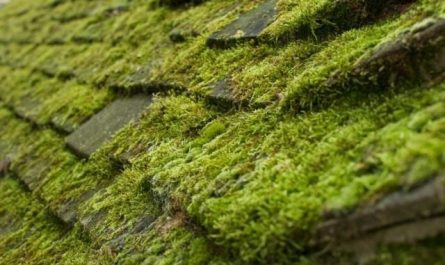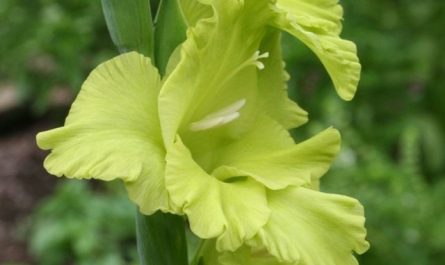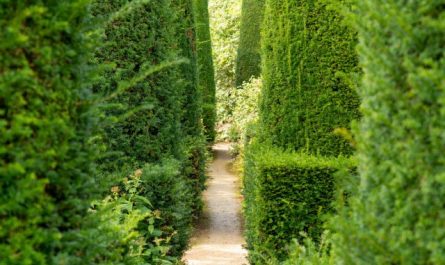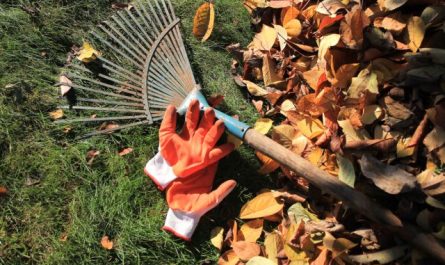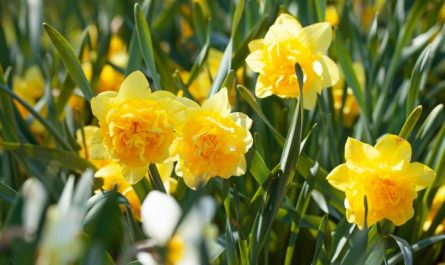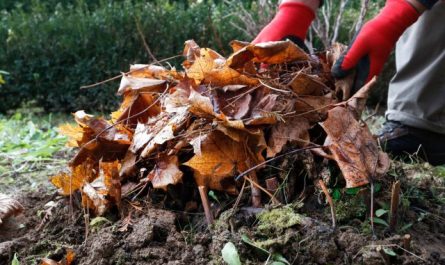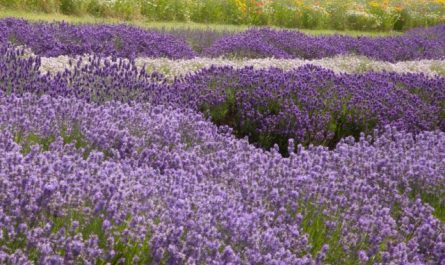Using dahlias for landscaping large areas
Currently, for landscaping residential areas of cities and towns, along with large-flowered double dahlias, mass plantings of dwarf non-double dahlias are widely used.
Most often, dahlias are planted in wide beds (15-20 plants per 1 m2), edging them with a border of silvery seaside cineraria or dark-leaved perilla. Sometimes, borders of lower plants, such as begonia semperflorens and alyssum, are planted in front of this border. The result is a beautiful double border.

The brightness and variety of colors of dwarf dahlias, early, abundant and long flowering of these plants, easy seed propagation make it possible to use them in large arrays in street decoration of cities and towns..
Dark-leaved dahlias are of great interest in group plantings. Particularly valuable among them are varieties with decorative foliage of a blackish-cherry, reddish-brown or yellow-bronze hue. The bright color of the inflorescences, expressed mainly in dark and bright orange and cherry-red tones, complements their decorativeness. Dark-leaved dahlias are used to create dark spots or borders on flowerbeds and borders with tall flowers. These dahlias, like dwarf ones, are often propagated by seeds and cultivated as annuals.

Large-flowered dahlias are very effective in mixed plantings (mixborders), especially along the main paths or fences and groups of shrubs in parks, gardens, squares. The basis of mixed flower beds are perennials with the addition of biennials and annuals. A characteristic feature of such a mixborder is that it blooms during the spring, summer and autumn. Plants in it are placed in small groups (of different shapes), simultaneously flowering groups can be repeated at certain intervals. In such plantings, dahlias should be placed in groups of 3-5-10 plants of the same variety.
Large-flowered and giant varieties of dahlias in a wide range should be used in larger arrays, convenient for viewing, the so-called dahlia gardens, where dahlias are arranged in groups by height (tall varieties in the second or third row, and lower ones – closer to the paths) taking into account the harmonious combination of colors and shape of inflorescences. Alternating groups of dahlias with warm and cold tones of colors look beautiful against the general background of a mown lawn.

Dahlias are arranged in large open sunny areas (or with rare groups of trees and shrubs) relatively flat or terraced, convenient for viewing from different sides..
When growing dahlias in spring, the plants can bloom in the middle zone from July until frost. For about 3 months, dahlias are not inferior in decorativeness to collections of other types of flowers and shrubs, such as rose gardens, syringaria, etc.
Sometimes dahlias are planted in flowerbeds located on sites in a garden or park at the intersection of two or more paths (alleys), as well as in areas in front of public buildings. The size of the flowerbeds usually ranges from 1,5 to 6-8 m (in diameter or width). The shape of such a flowerbed can be round or rectangular, with an increase in the center or flat. Flowerbeds with an increase in the center are usually arranged in areas with close standing groundwater or in areas with a large amount of precipitation.
Small flowerbeds and borders with single-color varieties of different classes – red, orange, pink, etc. – look impressive. Small low-growing pompom dahlias are planted as a border. A good border for dahlia plantings is also a trimmed kochia and silvery annual seaside cineraria. A flowerbed or border of dahlias, planted along the edges with sea alyssum (Bentham form A.), looks very beautiful. The white flowers of this low-growing plant, collected in brushes, have a pleasant honey smell, and their flowering continues until late autumn.
It is especially advisable to widely use dahlias in the eastern regions of the country, where many perennials cannot be used due to severe frosts in winter and deep soil freezing. Pre-grown dahlias give a good decorative effect.

Use of dahlias in small areas (summer cottage type) and in areas of enterprises and institutions
In home gardens, dahlias are planted along paths in one or more rows or in groups in various combinations with fruit and ornamental trees, shrubs and perennial flowers. When planting in two or three rows and when creating groups, it is necessary to take into account not only the shape, color and size of the inflorescence, but also the height of the bush, as well as the time of the beginning and abundance of flowering of the variety.
In the first row from the paths, low plants are planted, in the second – medium, in the third – high varieties. It is recommended to combine plantings of dahlias in gardens with plantings of other early flowering plants, so that the plots, flower beds, borders in the spring or early summer periods are not empty until the dahlias bloom. It is necessary that these plants create a decorative effect before the dahlias begin to bloom, since the joint flowering of these plants will weaken the colorful effect.

Peonies go very well with dahlias, producing lush blooms in early summer, and their beautiful dark green foliage can sometimes cover the bare stems of dahlias. It is also acceptable to plant dahlias with low-growing perennial phlox, preferably of the same variety, not very bright or contrasting in color.
When planting dahlias in an amateur garden or on the territory of an enterprise where a collection is displayed, it is necessary to do so in such a way as to highlight the color and shape of the inflorescences of each variety individually as vividly as possible..
It is necessary not only to have artistic taste, but also to be able to arrange dahlias by color, choosing smooth transitions of tones. For example, dahlias with lilac flowers can be planted next to dahlias with golden-yellow flowers, purple ones – with orange, white ones – with red and crimson, etc. The correct selection of varieties in groups is of great importance. It is necessary to remember that dahlias stand out very sharply among other ornamental plants in their size and strength, therefore, the wrong selection of colors of inflorescences and height of bushes can suppress individual varieties and deprive them of decorative value. It is useful to highlight individual varieties by planting one, two or three specimens against the background of the lawn. Large-flowered dahlias with abundant flowering are especially good for these plantings.
Author: N. A. Bazilevskaya.
